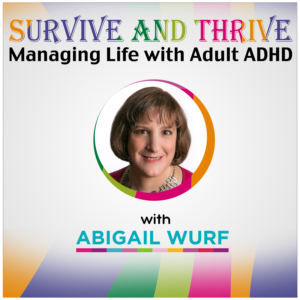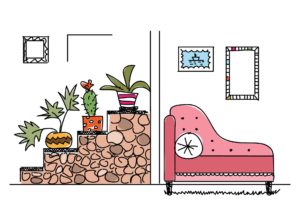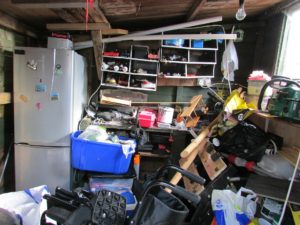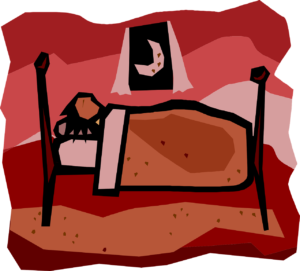 Find past episodes of the show below and be sure to subscribe on iTunes so you never miss an episode.
Find past episodes of the show below and be sure to subscribe on iTunes so you never miss an episode.
Your Home Should Be a Refuge (More on Clutter)
 Working with organizers and talking with my clients I find that one’s environment keeps coming up. Is the environment you are living in supportive of your overall living? I used to live in a terrible mess. I had too much stuff, stuff everywhere to the point you couldn’t see the floor in some rooms. This was a long time ago but I remember the overwhelm of living that way. Not surprisingly, it was also a time of great depression for me that I am sure contributed to my environment being what it was.
I have learned through my own experience and experiences my clients have communicated to me that living in a cluttered environment can affect you negatively. I believe it can diminish your energy. An environment of clutter is decisions not made. Decisions not made weigh on you. They clutter the back of your mind.
Having just moved I am experiencing this again because my bedroom has yet to be totally put away. I do the administration of my coaching business in my bedroom so I have a lot of stuff packed in. In addition to the usual bedroom furniture and items such as clothes, I have files, computer, printer, copier and office supplies in my bedroom. It is a lot of stuff for one room. Right now I have yet to find a home for everything so the room is definitely cluttered. That is a distraction and it leaches energy that could better be put to other useful things.
You probably have noticed if you have lived in a cluttered environment that there is often an intermittent dialogue going on in your brain of what you should be doing to fix the situation. Usually you do nothing and things continue to pile up and often get worse. The worse it gets the more you avoid doing something about it. The whole thing seems too stressful and overwhelming to deal with.
An answer is not to tackle the whole thing at once but to break it down into small chunks. Pick a place to start that is the least intimidating and involves the least decision-making, that may be a corner of the room or one type of object such as your files. Forget about the rest of the mess. You need to start somewhere. It is like eating a large pizza. You don’t lift up the whole thing up to eat. Instead you cut the pizza into slices and you eat a slice at a time. It doesn’t really matter which slice you start with just that you start with one slice. Eat until you are satisfied and put the rest of the pizza away for another time when you want more.
You can deal with clutter in the same way. Just do a chunk at a time. Complete the chunk and come back another day to do another chunk. The more that gets put away the more relaxing it will be in that environment. It helps you to focus on what you truly wish to focus on (which is already hard for us) without the distraction of a lot of clutter.
Once the clutter is under control you can better make your environment pleasing. A pleasing environment becomes a refuge, a refuge that feeds you energy rather than one that drains your energy.
Working with organizers and talking with my clients I find that one’s environment keeps coming up. Is the environment you are living in supportive of your overall living? I used to live in a terrible mess. I had too much stuff, stuff everywhere to the point you couldn’t see the floor in some rooms. This was a long time ago but I remember the overwhelm of living that way. Not surprisingly, it was also a time of great depression for me that I am sure contributed to my environment being what it was.
I have learned through my own experience and experiences my clients have communicated to me that living in a cluttered environment can affect you negatively. I believe it can diminish your energy. An environment of clutter is decisions not made. Decisions not made weigh on you. They clutter the back of your mind.
Having just moved I am experiencing this again because my bedroom has yet to be totally put away. I do the administration of my coaching business in my bedroom so I have a lot of stuff packed in. In addition to the usual bedroom furniture and items such as clothes, I have files, computer, printer, copier and office supplies in my bedroom. It is a lot of stuff for one room. Right now I have yet to find a home for everything so the room is definitely cluttered. That is a distraction and it leaches energy that could better be put to other useful things.
You probably have noticed if you have lived in a cluttered environment that there is often an intermittent dialogue going on in your brain of what you should be doing to fix the situation. Usually you do nothing and things continue to pile up and often get worse. The worse it gets the more you avoid doing something about it. The whole thing seems too stressful and overwhelming to deal with.
An answer is not to tackle the whole thing at once but to break it down into small chunks. Pick a place to start that is the least intimidating and involves the least decision-making, that may be a corner of the room or one type of object such as your files. Forget about the rest of the mess. You need to start somewhere. It is like eating a large pizza. You don’t lift up the whole thing up to eat. Instead you cut the pizza into slices and you eat a slice at a time. It doesn’t really matter which slice you start with just that you start with one slice. Eat until you are satisfied and put the rest of the pizza away for another time when you want more.
You can deal with clutter in the same way. Just do a chunk at a time. Complete the chunk and come back another day to do another chunk. The more that gets put away the more relaxing it will be in that environment. It helps you to focus on what you truly wish to focus on (which is already hard for us) without the distraction of a lot of clutter.
Once the clutter is under control you can better make your environment pleasing. A pleasing environment becomes a refuge, a refuge that feeds you energy rather than one that drains your energy.Clutter
 I took a class on clutter coaching. It trains you to coach people through managing their clutter. When I read about the course I thought it would help me help my clients deal with their clutter, a common problem for many people affected by ADHD. I also thought it would be good for me personally because I have a lot of stuff. I was about to move and needed to downsize my stuff.
I took a class on clutter coaching. It trains you to coach people through managing their clutter. When I read about the course I thought it would help me help my clients deal with their clutter, a common problem for many people affected by ADHD. I also thought it would be good for me personally because I have a lot of stuff. I was about to move and needed to downsize my stuff.
When I first read about the course I thought it was about organizing but it is not. It is about one’s relationship with their clutter. Much of what we choose to keep in our homes is about old identities, that is the people we used to be. For example, I had about 200 to 300 dance books because I used to be a dancer, dance teacher and choreographer. I haven’t worked professionally in the dance world for 20 years yet I still have all these books. I also realized I still had two drawers filled with dance clothes from many sizes ago. Why am I holding onto to these things when others could use them?
Popular right now is Marie Kondo’s The KonMari Method. Based on a book she wrote called “The Life-Changing Magic of Tidying Up: The Japanese Art of Decluttering and Organizing.” I will admit I never finished reading her book or the companion book “Spark Joy: An Illustrated Master Class on the Art of Organizing and Tidying Up.” What I have picked up and what is sweeping the organizing world is the idea of holding an object and asking the question, “Does it spark joy?” If it no longer sparks joy then is it necessary to keep?
The instructor of my clutter coaching class narrowed down the reasons we keep things that no longer serve us to seven excuses:
It was a gift
Just in case
I’ll get it fixed
My kids might want it
It’s worth a lot of money
I don’t want to add to landfills
It’s my spouse’s stuff
“Just in case” and “I’ll get it fixed” are two particularly difficult ones for those of us affected by ADHD. It allows us to hold on to things that we will never use again. As I often say to my ADHD clients much of our clutter is decisions not made. Not sure what to do with a document, just add it to the pile of documents already sitting on your desk. It becomes a decision for another day. Unfortunately that decision day often never arrives. Then it becomes clutter. The clutter grows and becomes overwhelming and unapproachable.
This is often when we need outside help. I recently wrote about professional organizers as a great resource to help clear away clutter in your life. Sometimes it is just too hard to do the decision-making and execution alone. If you lack the resources for an organizer or clutter coach, a friend or family member might be able to help as long as they have the proper mindset. They are there not to judge you but to support your effort to clear out some of the clutter in your life. They can help you see which items in your life no longer serve you and your current lifestyle.
Though it is hard to get rid of stuff, not just emotionally but physically, the absence of the unnecessary stuff gives you back physical and emotional space. The most important part is to make the decision that you want to reduce the clutter in your life because it is affecting your happiness. It weighs you down. I gave up a lot of my books, 44 boxes worth, which is hard because I love books but most of those books I hadn’t looked at in years. Though giving up stuff is hard, once the decision has been made it can be freeing.
I invite you to join me on this journey of freeing ourselves of items that no longer serve us or bring us joy.
Understanding, Forgiveness and Hope
 A while ago I was talking to someone like me who was diagnosed as an adult with ADHD. Our different perspectives were interesting to me. He was bitter and I was hopeful when first diagnosed. He was bitter because his first thought was how his life had been wasted. When I was first diagnosed I was hopeful and relieved. I was relieved because it meant I was not a bad and lazy person just someone facing legitimate challenges. I was hopeful because now that I was diagnosed maybe I could get proper help and my life would improve. That is what happened!
A while ago I was talking to someone like me who was diagnosed as an adult with ADHD. Our different perspectives were interesting to me. He was bitter and I was hopeful when first diagnosed. He was bitter because his first thought was how his life had been wasted. When I was first diagnosed I was hopeful and relieved. I was relieved because it meant I was not a bad and lazy person just someone facing legitimate challenges. I was hopeful because now that I was diagnosed maybe I could get proper help and my life would improve. That is what happened!
People don’t wake up and say, “I wish I had ADHD.” Nor do they say, “When I have children I hope they have ADHD.” Having ADHD is a hard life and obviously the earlier you get help the better. But I don’t think life before diagnosis is a waste. What it is, is a struggle. After a diagnosis life is still a struggle. It is just a different struggle. A hopeful one I would argue.
Prior to diagnosis our struggle can feel hopeless. We believe we are lazy and maybe even bad. Also that life will always be this way. I believe the diagnosis gives us understanding, forgiveness and hope. Understanding why we do or don’t do things helps us not to judge ourselves. Explanations don’t necessarily remove problems but they give us clues on how to solve or manage situations better.
Forgiving oneself is important. We can’t go back and change the past but we can shift how we deal with the future. There is hope in that shifting. As the saying goes, knowledge is power. It is not always a solution but it can lead us toward opportunities that may provide solutions. If not solutions, at least better ways to live our life post diagnosis.
I also believe that every experience is an opportunity. Even negative experiences can present an opportunity. We always have a choice to dwell on the negativity of the experience or to seek out what we could learn from the experience. Many years ago I had back surgery and unfortunately ended up being in more pain post surgery than prior to surgery. The chronic pain lasted for years and could have stolen my life. Instead I decided to look inward to see if I had gained anything from the experience. I found I had. I had survived something really difficult. This gave me a sense of accomplishment. It helped build up my self esteem. It also made me realize that managing chronic pain for over a decade involves internal strength. I could use that strength in other areas of my life. I also developed a greater empathy for others struggling.
Just as those with ADHD struggle we can choose to find strength in that struggle. Getting up each day and facing the world knowing it is going to be struggle shows great fortitude. Simply not giving up is true strength. There is also a hopefulness in the act of getting up each day and not giving up before you even begin. I tell many of my clients when they are discouraged that simply coming to coaching is a hopeful act. You wouldn’t have bothered to find much less see an ADHD coach if you had totally given up. What would be the point?
Part of having ADHD is messing up. But you have a choice as to whether or not you forgive yourself in that moment and endeavor to try to do better. You have the choice to try and understand what is happening and look for solutions. You have the choice to maintain hope.
Avoiding a Second Wind at Night
 As an ADHD coach I work with a lot of people who struggle to go to bed at a reasonable time at night, often causing their mornings to be tough. I used to be one of those people who would stay up late at night and then struggle to get up in the morning. Or I would sleep late into the morning causing me to go to bed late that night and perpetuate a cycle.
As an ADHD coach I work with a lot of people who struggle to go to bed at a reasonable time at night, often causing their mornings to be tough. I used to be one of those people who would stay up late at night and then struggle to get up in the morning. Or I would sleep late into the morning causing me to go to bed late that night and perpetuate a cycle.
Many people affected by ADHD find it hard to fall asleep at night so they avoid going to bed. It is no fun to lie in bed unable to sleep. It can be extremely frustrating. Our brains struggle to turn off so that we can quiet down and fall asleep. Another problem is that we often get a second wind at night that is like a jolt of energy. That energy leads us to start doing things, often things we did not get done during the day. Then we stay up late.
My solution is to go to bed early enough that you are not up and about to get a second wind. Also do calming things prior to bedtime in a ritual manner to start slowing down and not to get revved up again before closing your eyes.
Once I realized I was going to bed later and later I started moving my bedtime earlier by a half hour every few days. Unfortunately I struggled. I began to realize the solution wasn’t just moving my bedtime earlier incrementally but what I was doing before my bedtime.
About 45 minutes before I want to be asleep I start my nighttime routine. Everyone’s routine may be different but it includes changing for bed, washing up and brushing your teeth. It may also include laying out your clothes and packing your bag for the next day. Whatever works for you. After I am ready for bed I do only quiet activities such as reading in bed. Then at the time I designated as bedtime I turn out the lights. Usually before turning out the lights I start a podcast to listen to as I go to sleep because it helps to shut my thoughts down.
There is a trick to this. Don’t turn on an intriguing podcast that will rev you up. Instead listen to a semi-boring podcast. My favorite to fall to sleep to is called “Sleep with Me.” I fast forward through the opening introductions and sponsorships. This podcast is an acquired taste. As the host says, try it a few times before you make up your mind. He has hundreds of episodes so you can listen to it every night.
The most important things about getting to sleep are not to stay up so late you get a second wind, not to start new activities late in the night and to develop an evening routine. The routine helps slow down and make the transition towards sleep.
The Pomodoro Technique
 I am always being asked for the best productivity and time management techniques. There is no one answer: different methods work for different people. Also it is common for those affected by ADHD to get bored with a system after awhile even if works well for them. This means we always need to be collecting new ways of doing things that work for us.
I am always being asked for the best productivity and time management techniques. There is no one answer: different methods work for different people. Also it is common for those affected by ADHD to get bored with a system after awhile even if works well for them. This means we always need to be collecting new ways of doing things that work for us.
One method popular with those affected by ADHD is the Pomodoro Technique. Invented by Francesco Cirillo in the late 1890s, this technique uses a timer to work in intervals of 25 minutes. Between each 25 minute interval a three to five minute break is taken. After four intervals a longer break of 15 to 30 minutes is taken. It is important to choose the task you are going to undertake before starting the timer so that you are on task during the full 25 minute interval. Track the intervals, maybe with a check mark on a piece of paper, so you know when you have done four intervals and can take a longer break.
It is also helpful to track what you did during each interval so that you begin to learn how long in takes you to accomplish certain tasks. Many of those affected by ADHD have little sense of how long different tasks take even if they are tasks they do often. This can be helpful information in planning your day and what you plan to accomplish.
As for the name, pomodoro means tomato in Italian. The timer that Cirillo used while at university was shaped like a tomato. So we have the Pomodoro Technique.
ADHD and Mindset
 Being affected by ADHD day in and day out is not easy. We often talk about such things as to how to get things done, how to stop procrastinating and how to get places on time. These are important things to discuss but what is also important is working on our mindset. As a certified coach I have to take continuing education classes to maintain my certification. The last class I took and the class I am currently taking involve mindset. The classes are focused for coaches and in each class I have been the only coach who works with people affected by ADHD. What has amazed me is how helpful what I am learning could be for those affected by ADHD.
Being affected by ADHD day in and day out is not easy. We often talk about such things as to how to get things done, how to stop procrastinating and how to get places on time. These are important things to discuss but what is also important is working on our mindset. As a certified coach I have to take continuing education classes to maintain my certification. The last class I took and the class I am currently taking involve mindset. The classes are focused for coaches and in each class I have been the only coach who works with people affected by ADHD. What has amazed me is how helpful what I am learning could be for those affected by ADHD.
The last class I took focused on the work of Carol S. Dweck who wrote the book “Mindset: The New Psychology of Success.” Dweck says that at anytime we are either in a “fixed” mindset or “growth” mindset. When faced with a challenge, a “fixed” mindset would only see the options of success or failure while a “growth” mindset would see opportunity in the challenge and experience. Those with a “growth” mindset would get something out of the experience regardless the outcome.
The class I am taking now is taught by Marilee Adams and is based on her book “Change Your Questions Change Your Life.” Adams’ work is focused on the idea that if you ask “learner” instead of “judger” questions of yourself and others you will be happier and more successful. “Judger” questions like “Why am I always a failure?” or “Why is that person always telling me what to do?” can lead up to a dead end. On the other hand “learner” questions such as “What can I learn in this situation?” or “What assumptions am I making about this person and their point of view?” lead to greater possibility.
Understanding the differences between a “fixed” and “growth” mindset and the “judger” and “learner” questions can change both the internal dialogues we have within ourselves and the external dialogues we have with others. Often we have a “fixed” mindset or a “judger” question when interacting with others or ourselves. If we shift ourselves into a “growth” mindset or start asking “learner” questions a switch to possibilities occurs within ourselves and with others.
People affected by ADHD can become extremely judgmental about themselves. I hear it all the time from clients. This harshness towards themselves limits their lives and happiness. I know it is something I struggle with myself. What I have been trying to do is take a pause before I speak or act and ask myself “what is my mindset?” If I am of a “fixed” or “judger” mindset, I then ask myself if I can switch to a “growth” or “learner” mindset and what would that look like. This is a learning process. Some days I do better than other days but I am having a more open and positive outlook. Try it yourself and see.
